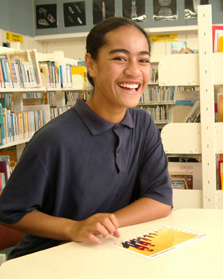![]() STUDENTS’
ATTITUDES TO LEARNING, 1995–1998
STUDENTS’
ATTITUDES TO LEARNING, 1995–1998
![]()
Liz
Eley
Many
factors influence student achievement in a learning area, including
a positive attitude, enjoyment of a subject, and opportunities
to experience success. Between 1995 and 1998, surveys monitoring
students’ attitudes and motivations towards different learning
areas were conducted in conjunction with the NEMP assessments
in 12 such areas. This study examines some of the different patterns
that emerged when student responses were analysed. |
The learning
areas surveyed over the four-year cycle were science, art, reading, speaking,
technology, music, mathematics, library and research skills, social studies,
writing, health, and physical education. For each of these surveys, about
460 students at each of the two year levels assessed (4 and 8) completed
a questionnaire, but each student took part in a survey of one learning
area only. Students completed their questionnaire privately, although
a teacher was available to read the questions or record responses if required.
•
When asked to rank order their subjects in terms of preference,
students gave as their ‘favourites’ art, physical education,
and mathematics.
|
•
Students gave positive enjoyment ratings responses for six learning
areas in their own time. However, there was a substantial decrease
in their enjoyment rating of writing and mathematics between Years
4 and 8. • Students also responded very positively when asked how good they thought they were in different learning areas. • Girls were more positive than boys in their responses in six learning areas: music, writing, reading, art, health, and speaking. Boys were more positive than girls in their responses in three learning areas: technology, physical education, and science. These differences were more pronounced at Year 8 than Year 4. • Year 4 Mäori students were more positive than non-Mäori students in six learning areas, while non-Mäori students were more positive about speaking. At Year 8, Mäori students were more positive about art and music, with no significant differences in other learning areas. Despite the more positive disposition of Mäori students, the achievement results of non-Mäori students were higher in every area except physical education. • Students from schools with low decile ratings were more positive than their counterparts from schools with middle and high decile ratings in seven learning areas, but this pattern was not reflected in the achievement results. |
![]()
•
The strong link between positive attitudes towards learning and subsequent
achievement identified in the literature suggests teachers need to optimise
learning opportunities for students by providing learning contexts and
experiences that are motivational for the whole range of students.
• The generally highly positive attitude to learning shown by students
at Years 4 and 8 is heartening. However, the findings that older students
have less positive attitudes to learning than younger students, and that
boys have less positive attitudes to learning than girls, suggest that
the learning environment for older students and boys requires attention.
• Although Mäori students and students from low decile schools
tend not to achieve as well as their non-Mäori and higher school
decile peers, their very positive attitude to learning provides a good
starting place for closing the achievement gap between the various subgroups.
